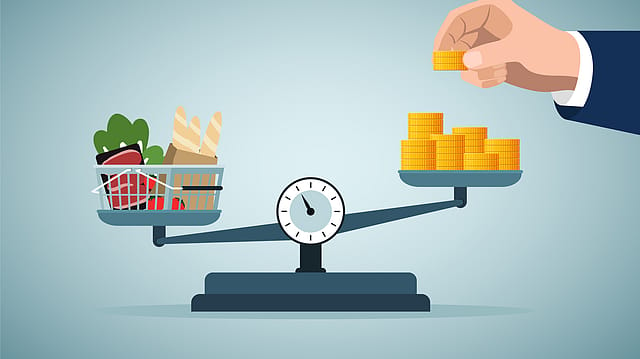Wholesale inflation falls to 10.7% in September
ADVERTISEMENT

India's annual rate of inflation based on the Wholesale Price Index (WPI) number eased to 10.7% for the month of September, 2022 compared with 12.41% recorded in August 2022, government data showed on Friday. The number has remained in double digits for the 18th consecutive month.
The decline in WPI inflation in September was aided by a sharp drop in prices of food items and manufactured products, according to the Ministry of Commerce & Industry. The rate of inflation based on WPI Food Index decreased from 9.93% in August to 8.08% in September.
Inflation in September, 2022 is primarily contributed by rise in prices of mineral oils, food articles, crude petroleum & natural gas, chemicals & chemical products, basic metals, electricity, textiles etc. as compared to the corresponding month of the previous year, the ministry says in a statement.
In the fuel and power basket, inflation eased to 32.61% in September as against 33.67% in August. For manufactured products, WPI inflation declined to 6.34% from 7.51%.
The WPI data comes days after India's Consumer Price Index (CPI)-based inflation or retail inflation rose to a five-month high of 7.41% in September 2022 from 7% in August 2022 on high food prices, erratic rains, and global supply-chain issues arising out of the Russia-Ukraine war.
Earlier this week, S&P Global Ratings said India is facing a mixture of factors that may shake its sovereign credit metrics amid falling foreign exchange reserves and rising current account deficit.
January 2026
Netflix, which has been in India for a decade, has successfully struck a balance between high-class premium content and pricing that attracts a range of customers. Find out how the U.S. streaming giant evolved in India, plus an exclusive interview with CEO Ted Sarandos. Also read about the Best Investments for 2026, and how rising growth and easing inflation will come in handy for finance minister Nirmala Sitharaman as she prepares Budget 2026.
The fall in its foreign exchange reserves to around $533 billion currently, from a peak of about $634 billion in 2021, is driven in part by India's growing current account deficit, which is expected to jump to 3% of GDP in the current fiscal year, versus just 1.6% of GDP in fiscal year ended March 2022, as the country's import bill surges, the ratings agency says.
S&P retained its forecast for inflation to average 6.8% in fiscal 2023, before falling to 5.0% in fiscal 2024 and 4.5% per year beyond that. "A stress scenario assuming consumer price inflation and benchmark interest rates surpassing our current forecasts by 300 bps and 250 bps, respectively, for an extended period of time, could put more pressure on the sovereign ratings. This is because such a development could entail significantly slower economic growth, higher net general government fiscal deficits and net indebtedness, and a weakening of India's institutional capacity to maintain sustainable public finances," said S&P Global Ratings.
